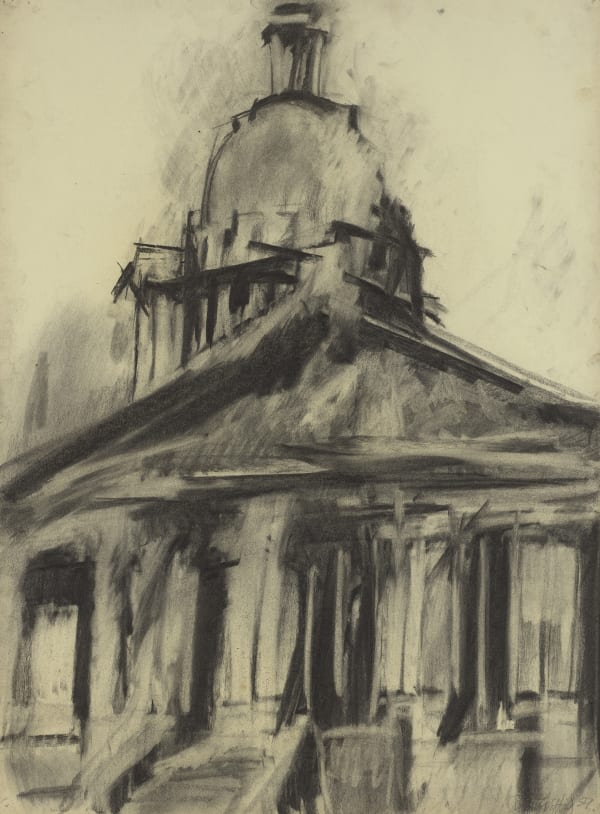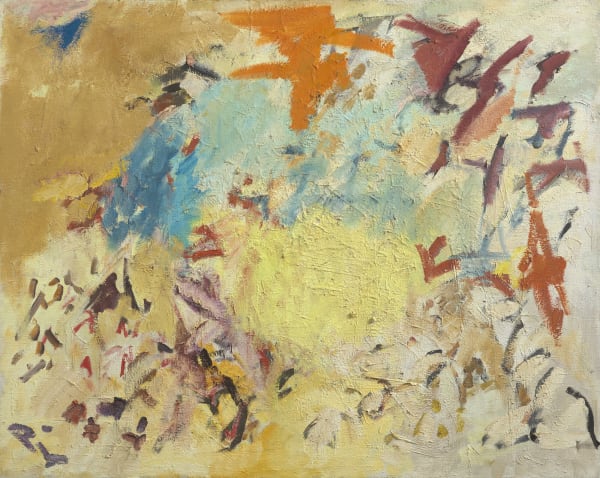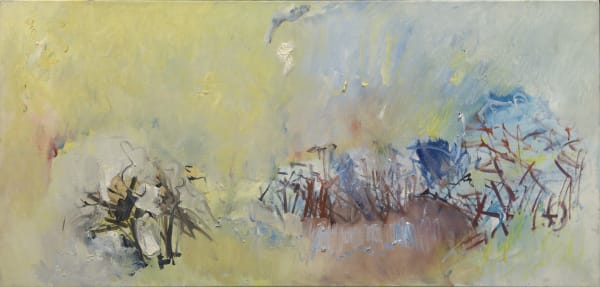-
‘Creffield’s work became more light, airy, and – an unusual quality, especially in post-war figurative art – joyous’ — Martin Gayford
Creffield developed a lifelong love affair with English architecture while painting the blasted vistas of post-war London as a student at the Slade – but his works were never architectural draughtsmanship, rather intimate engagements with the meaning and the mood that buildings confer on place. Depicting cities and their structures was a means for Creffield to engage not only with the contemporary life that surrounded him, but also with the survival of history into the present that architecture embodies. His most celebrated engagement with architecture remains his series of cathedral drawings – but over the course of his long career he veered often from the sacred into the profane.
His earliest cityscapes were massy, brooding London scenes, painted from the roof of Christopher Wren’s Royal Observatory in Greenwich – one early work was praised by the influential critic David Sylvester as the ‘most impressive’ on show at an exhibition in 1959, with ‘the restless shapes of the jagged brush-strokes settl[ing] down into a clear precise luminous structure.’ But he later ranged to a rather different vantage point on Englishness – the industrial north, under continual construction, which he painted from the roof of Leeds University. His move to Brighton – ‘this skittish, singing town’ as he called it – freed up his palette, pushed him closer (but never entirely) to abstraction, and allowed him to reconcile his love of the cityscape with his interest in the sensuous life; Brighton was, he explained, ‘a fine, seedy, romantic place to dwell’. But he continued also to engage with the spiritual, especially in his remarkable series of landscapes from the Holy Land from the 1990s.
Later commissions – to paint Petworth in West Sussex like his hero, Turner, or else the obsolete military pagodas at Orford Ness on the Suffolk coast – show Creffield able to tune himself to different modes or moods, all in the service of his attempt to ‘reconcile geometry with the organic’. The novelist Peter Ackroyd wrote in 1993 of his Petworth works: ‘The great floods of colour and the bright tonality continue Turner's own fantastic ceremonies of light, but in Creffield's paintings there is always the sense of the house and its land as organic, breathing forms.’ Of his depictions of Orford Ness, the architectural historian Jeremy Musson wrote: ‘Abandoned for twenty years the buildings on [Orford] Ness seem as if they belong to a different world [...] Such a remarkable landscape requires a remarkable artist to understand and interpret it: Dennis Creffield is such an artist’.
-
-
 Isle of Dogs from Greenwich Observatory, 1950Oil on board71.2 x 91.4cm
Isle of Dogs from Greenwich Observatory, 1950Oil on board71.2 x 91.4cm
Tate, London -
 Greenwich from Royal Observatory, 1958Oil on board71 x 92cm
Greenwich from Royal Observatory, 1958Oil on board71 x 92cm -
 Royal Naval College, Greenwich, 1959Charcoal on paper94 x 75cm
Royal Naval College, Greenwich, 1959Charcoal on paper94 x 75cm -
 Royal Naval College from the Observatory, 1950Charcoal on paper57.2 x 76cm
Royal Naval College from the Observatory, 1950Charcoal on paper57.2 x 76cm -
 Greenwich, Looking Down River, 1960Charcoal on paper58.4 x 80cm
Greenwich, Looking Down River, 1960Charcoal on paper58.4 x 80cm -
 Halifax, 1965Oil on canvas126.5 x 152.5cm
Halifax, 1965Oil on canvas126.5 x 152.5cm
Private collection -
 Leeds, from the Roof of the University, 1965Oil on canvas101 x 126.3cm
Leeds, from the Roof of the University, 1965Oil on canvas101 x 126.3cm
Ferens Art Gallery, Kingston Upon Hull -
 Leeds, from the Roof of the University, 1965Oil on canvas91.4 x 101.6m
Leeds, from the Roof of the University, 1965Oil on canvas91.4 x 101.6m
Leeds Art Gallery, Leeds Museums and Galleries -
 Brighton Birds in Sussex Square, 1968Acrylic on canvas63.5 x 76cm
Brighton Birds in Sussex Square, 1968Acrylic on canvas63.5 x 76cm -
 Lewes Crescent and Garden from West, 1970Oil on canvas91 x 122cm
Lewes Crescent and Garden from West, 1970Oil on canvas91 x 122cm -
 Brighton on the Shore, 1968Oil on canvas129 x 104cm
Brighton on the Shore, 1968Oil on canvas129 x 104cm -
 On the Shore, Brighton, 1974Oil on canvas102 x 128cm
On the Shore, Brighton, 1974Oil on canvas102 x 128cm
Private collection -
 Brighton Beach, East Sussex, c. 1974Oil on canvas76.2 x 101.3cm
Brighton Beach, East Sussex, c. 1974Oil on canvas76.2 x 101.3cm
Brighton and Hove Museums and Art Galleries -
 Brighton Pier: Summer Day, 1974Oil on canvas105 x 131cm
Brighton Pier: Summer Day, 1974Oil on canvas105 x 131cm -
 Brighton Pier, 1985Oil on canvas91 x 86 cm
Brighton Pier, 1985Oil on canvas91 x 86 cm -
 July Evening, Brighton, 1985Oil on canvas
July Evening, Brighton, 1985Oil on canvas
86.4 x 91.4cm
University of Sussex -
 Winter Storm from Studio, 1985Oil on canvas86 x 91cm
Winter Storm from Studio, 1985Oil on canvas86 x 91cm -
 Petworth House, South End from the East, 1991–92Oil on canvas77 x 87cm
Petworth House, South End from the East, 1991–92Oil on canvas77 x 87cm -
 Petworth House, South End from the East, 1991–92Oil on canvas79 x 89cm
Petworth House, South End from the East, 1991–92Oil on canvas79 x 89cm -
 Petworth House: Heavy Storm, 1992Oil on canvas73 x 88cm
Petworth House: Heavy Storm, 1992Oil on canvas73 x 88cm -
 Petworth Park, Winter, 1991–92Oil on canvas63.5 x 132cm
Petworth Park, Winter, 1991–92Oil on canvas63.5 x 132cm -
 Magdalene College, Cambridge, Pepys Library, 1992Oil on canvas51 x 63.5cm
Magdalene College, Cambridge, Pepys Library, 1992Oil on canvas51 x 63.5cm -
 The Pagoda: Big Storm Summer, 1994Oil on canvas83.8 x 126.5cm
The Pagoda: Big Storm Summer, 1994Oil on canvas83.8 x 126.5cm -
 Orford Ness: Pagoda (Lab 4), 1994Charcoal on paper53 x 73cm
Orford Ness: Pagoda (Lab 4), 1994Charcoal on paper53 x 73cm
British Museum, London -
 Jerusalem Sunrise, 1994Oil on canvas70 x 80cm
Jerusalem Sunrise, 1994Oil on canvas70 x 80cm -
 Jerusalem: Mount of Olives + Dome of the Rock from Petra Hotel, 1994Charcoal on paper55.5 x 76.5cm
Jerusalem: Mount of Olives + Dome of the Rock from Petra Hotel, 1994Charcoal on paper55.5 x 76.5cm -
 Tate Modern: Turbine Hall, 1995Oil on canvas113 x 96cm
Tate Modern: Turbine Hall, 1995Oil on canvas113 x 96cm -
 Tate Modern: Turbine Hall Before Conversion, 1995Charcoal on paper76.5 x 55.5cm
Tate Modern: Turbine Hall Before Conversion, 1995Charcoal on paper76.5 x 55.5cm -
 Lower Manhattan from New Jersey (Hoboken), 1996Charcoal on paper57 x 77.5cm
Lower Manhattan from New Jersey (Hoboken), 1996Charcoal on paper57 x 77.5cm
Pallant House Gallery, Chichester -
 Lower Manhattan from under the Brooklyn Bridge (Version 1), 1996Charcoal on paper57 x 77.5cm
Lower Manhattan from under the Brooklyn Bridge (Version 1), 1996Charcoal on paper57 x 77.5cm
Pallant House Gallery, Chichester -
 Looking South West: Old Bailey + Cranes, 1999Oil on paper76.2 x 55.9cm
Looking South West: Old Bailey + Cranes, 1999Oil on paper76.2 x 55.9cm
Private collection -
 Raglan Castle, 2001Acrylic on paper92 x 102cm
Raglan Castle, 2001Acrylic on paper92 x 102cm -
 White Castle, 2001Acrylic on board51 x 76.5cm
White Castle, 2001Acrylic on board51 x 76.5cm
-
































